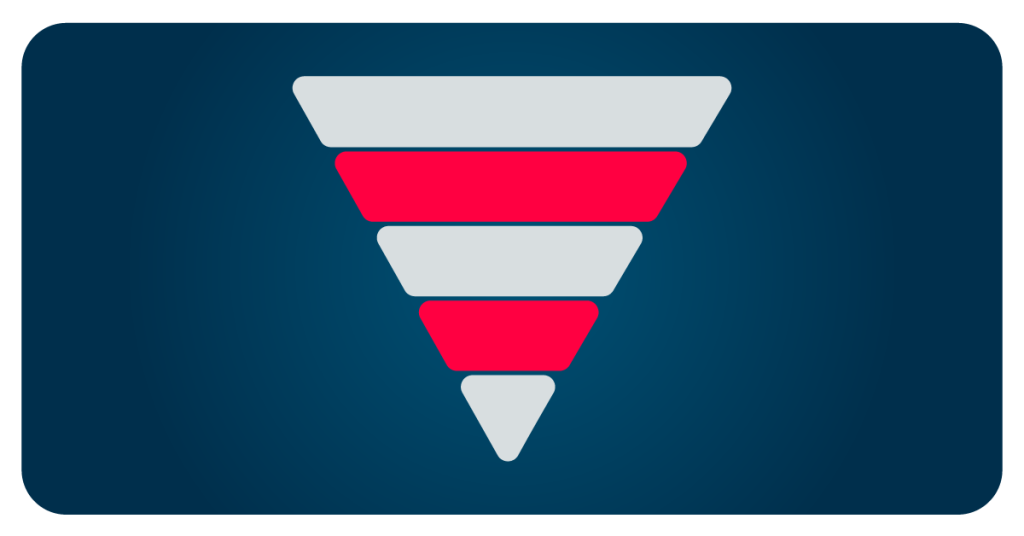Regardless of the business you’re in, you’ve surely heard about how successful sales plans account for a considerable portion of the revenue. That’s true – with good preparation come great results! However, creating a simple document that should outline the entire customer journey and details how to best guide them through it is no easy task.
That’s why we wrote this article! In this guide, you’ll find all the steps you need to take in order to draft the best sales funnel for your business and increase profits easily.
What is a Sales Funnel?
The sales funnel, as we already mentioned, is a document that shows the phases through which a person has to go in order to become a customer. It’s usually visual, and it illustrates how the widest pool of potential clients is at the top – those are the people who aren’t yet acquainted with your business. The very end of the journey is the narrowest, but it includes the people who are sure to make a purchase with you.
The number of steps you need to take in order to lead the customer all the way down depends on your business type. That’s just one of the reasons this document is highly individual and needs to be created for each company. However, although the exact phases will differ, there are some universal, broader levels of the funnel that will apply to all businesses.
- Level 1: Prospects – the people who fit your ideal customer persona,
- Level 2: Leads – the prospects who have learned about your business,
- Level 3: Warm leads – the leads who are now interested in your company,
- Level 4: Hot leads – the warm leads who are ready to close the deal.
As you may have guessed, the individual part of the sales funnel is the actions you and your team can take to bring awareness to your company, pique the audience’s interest, and finally inspire them to make the final decision to do business with you.
But how do you decide which actions are the best?

Internal Decisions
Before you go out looking for leads, it’s essential to work out some aspects of your offer internally. First, you need to know which problems you are solving. This will help in creating the ICP and, in turn, identifying prospects. Once you know your customers’ pain points, you’ll have a much clearer picture of whether or not they’re likely to venture down your funnel.
You’ll also need to define your sales goals. These goals should be clear and concrete – it’s best you put them in numbers. For example, you could set the number of downloads you want to see on your lead magnet or the number of appointments your team books. The KPIs should be set for each phase of the funnel, which will help in determining whether the funnel works or not. Having smaller goals for each step can be a good indicator of where your bottlenecks are, which will make any potential issues much easier to fix.
Generate Interest
Once you have an idea of who you want to target (and which problems you can solve for them), you need to let them know that your company exists. That’s why this step is best done when the sales and marketing teams work closely together.
The sales team should create an offer that will be a good way to get to know your company. This could be, for example, a free demo or trial or an e-book or other useful document. Then, the marketing team will help you identify the best channels and methods for communicating this offer.
Qualify Your Leads
Just because someone has expressed interest in the free version of your service doesn’t mean that they’re a great fit for a prolonged partnership. That’s why the next step for your sales team is lead qualification. This process also needs to be backed up by internal decisions, so refer back to the ICP you drafted earlier.
For example, the new lead may be facing issues that you can solve, but they don’t have the power to make that decision within their company, or their financial situation doesn’t align with your pricing. Unfortunately, if this is the case, that means that the lead is no longer a lead and will exit the funnel prematurely.
On the other hand, if they fit the more specific criteria as well, that just means they’re much more likely to end up closing the deal!
Nurture the Leads
Naturally, the person who expressed interest in your company and fits all your criteria isn’t going to make the decision to purchase right away. Thankfully, you’ve gathered their contact information and can continue to guide them toward that decision.
The most popular (and reliable) way to do so is via email campaigns. Use their address to send them useful information regarding your company’s benefits, highlight how you can help, and invite them to take the next step. The important thing to remember here is that you should limit your efforts to a maximum of 5 emails spread out across 7-10 days to avoid getting blocked for sending spam.
The emails should contain a clear call to action – leave a link where they can book a meeting with you and tell them directly what they’ll gain from it. If, even after these personalized messages, they don’t respond, it’s unlikely they’ll become a customer. But if they do – congratulations! You’re just one conversation away from closing the deal.
Follow Up Even After They’re Through the Funnel
If someone has expressed trust in you and has become a customer, that doesn’t mean you should lose contact. Your team can send out occasional emails, most commonly in the form of an informative newsletter. Here, you should add a personal touch with, for example, company news. This will only deepen the relationship you have with them.
But the newsletter should also contain a section with updates on your services or products. Here, you can let them know if something new is available or if there is a way to upgrade their previous purchase. For example, software companies often use this channel to promote app maintenance services, while product vendors seize the opportunity to talk about their new collections.
Your clients are much more likely to reach out to you for upgrades and novelties since you’ve already proven yourself to be a trustworthy and reliable partner.
Monitor Your Progress
Set a specific time frame after which you will re-evaluate the funnel you created. These meetings are usually held quarterly or yearly, but shorter time frames work if you want to check on progress on the smaller goals you set for the specific phases.
The aim here is to ensure that the funnel works as intended and to check if any of the specific phases seem to stand out in terms of losing prospects. Then, with this information, you can work out a strategy to overcome these challenges and improve the funnel.
Key Takeaways
Sales funnels are maps illustrating the phases a person goes through to go from passer-by to returning customer. These documents need to be carefully crafted and regularly monitored in order to yield the best results.
There is no one magical formula that will work for every business – each company needs to have a sales funnel that is created with specific needs in mind. NextPilots can help with that!
We are a team of experienced sales and outreach professionals who can handle the creation of the sales funnel for you. We work closely with all our partners, hear them out in terms of goals and requirements, and then draft the best solution. You can also rely on us to help identify and remove any roadblocks along the way.
Book a call with us, and we’ll help you exceed your sales expectations!

